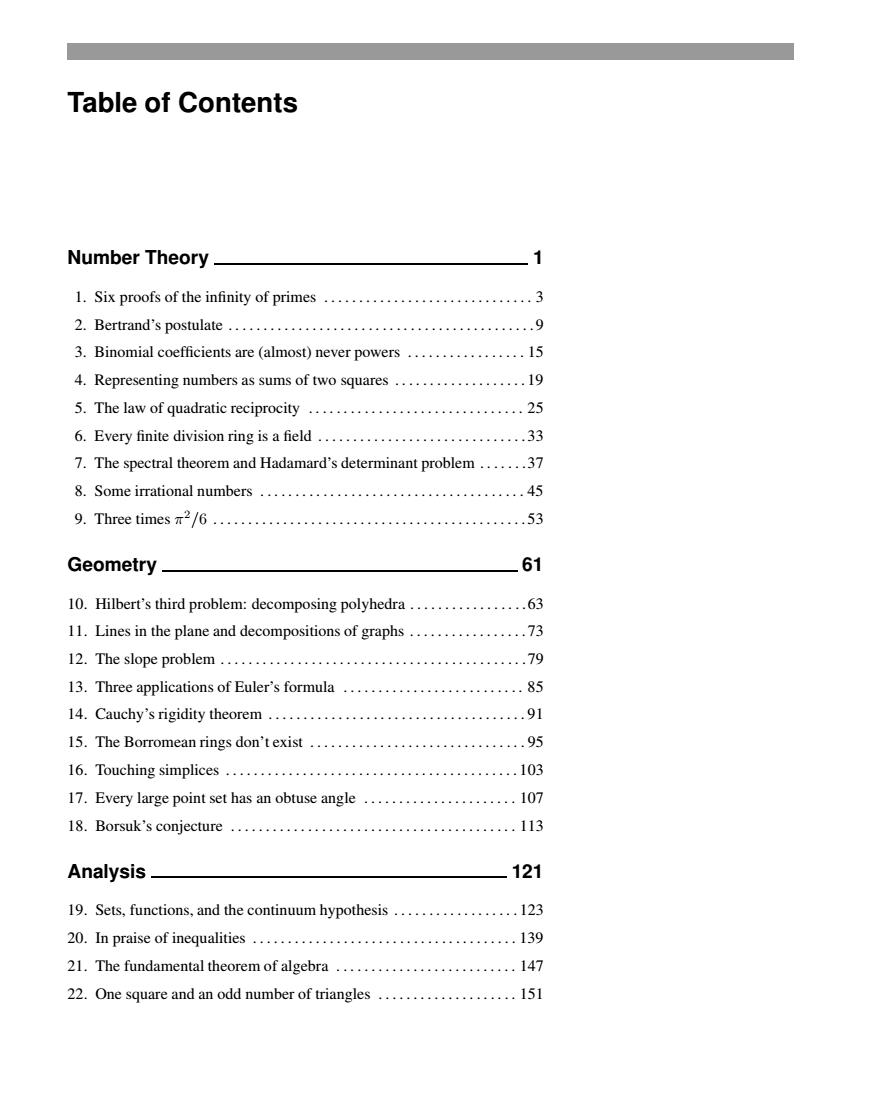正在加载图片...

Table of Contents Number Theory_ .1 1.Six proofs of the infinity of primes..............................3 2.Bertrand'spostulate.......................................9 3.Binomial coefficients are(almost)never powers.................15 4.Representing numbers as sums of two squares...................19 5.The law of quadratic reciprocity ...............25 6.Every finite division ring is a field..............................33 7.The spectral theorem and Hadamard's determinant problem.......37 8.Some irrational numbers......................................45 9.Three times2/6................53 Geometry_ 61 10.Hilbert's third problem:decomposing polyhedra.................63 11.Lines in the plane and decompositions of graphs.................73 12.The slope problem................................79 13.Three applications of Euler's formula..........................85 14.Cauchy's rigidity theorem.....................................91 15.The Borromean rings don't exist...............................95 16.Touching simplices..........................................103 17.Every large point set has an obtuse angle...................... 107 18.Borsuk'sconjecture.........................................113 Analysis 121 19.Sets,functions,and the continuum hypothesis..................123 20.In praise of inequalities......................................139 21.The fundamental theorem of algebra..........................147 22.One square and an odd number of triangles ....................151Table of Contents Number Theory 1 1. Six proofs of the infinity of primes . . . . . . . . . . . . . . . . . . . . . . . . . . . . . . 3 2. Bertrand’s postulate . . . . . . . . . . . . . . . . . . . . . . . . . . . . . . . . . . . . . . . . . . . . 9 3. Binomial coefficients are (almost) never powers . . . . . . . . . . . . . . . . . 15 4. Representing numbers as sums of two squares . . . . . . . . . . . . . . . . . . . 19 5. The law of quadratic reciprocity . . . . . . . . . . . . . . . . . . . . . . . . . . . . . . . 25 6. Every finite division ring is a field . . . . . . . . . . . . . . . . . . . . . . . . . . . . . . 33 7. The spectral theorem and Hadamard’s determinant problem . . . . . . .37 8. Some irrational numbers . . . . . . . . . . . . . . . . . . . . . . . . . . . . . . . . . . . . . . 45 9. Three times π2/6 . . . . . . . . . . . . . . . . . . . . . . . . . . . . . . . . . . . . . . . . . . . . . 53 Geometry 61 10. Hilbert’s third problem: decomposing polyhedra . . . . . . . . . . . . . . . . .63 11. Lines in the plane and decompositions of graphs . . . . . . . . . . . . . . . . . 73 12. The slope problem . . . . . . . . . . . . . . . . . . . . . . . . . . . . . . . . . . . . . . . . . . . .79 13. Three applications of Euler’s formula . . . . . . . . . . . . . . . . . . . . . . . . . . 85 14. Cauchy’s rigidity theorem . . . . . . . . . . . . . . . . . . . . . . . . . . . . . . . . . . . . . 91 15. The Borromean rings don’t exist . . . . . . . . . . . . . . . . . . . . . . . . . . . . . . . 95 16. Touching simplices . . . . . . . . . . . . . . . . . . . . . . . . . . . . . . . . . . . . . . . . . . 103 17. Every large point set has an obtuse angle . . . . . . . . . . . . . . . . . . . . . . 107 18. Borsuk’s conjecture . . . . . . . . . . . . . . . . . . . . . . . . . . . . . . . . . . . . . . . . . 113 Analysis 121 19. Sets, functions, and the continuum hypothesis . . . . . . . . . . . . . . . . . . 123 20. In praise of inequalities . . . . . . . . . . . . . . . . . . . . . . . . . . . . . . . . . . . . . . 139 21. The fundamental theorem of algebra . . . . . . . . . . . . . . . . . . . . . . . . . . 147 22. One square and an odd number of triangles . . . . . . . . . . . . . . . . . . . . 151